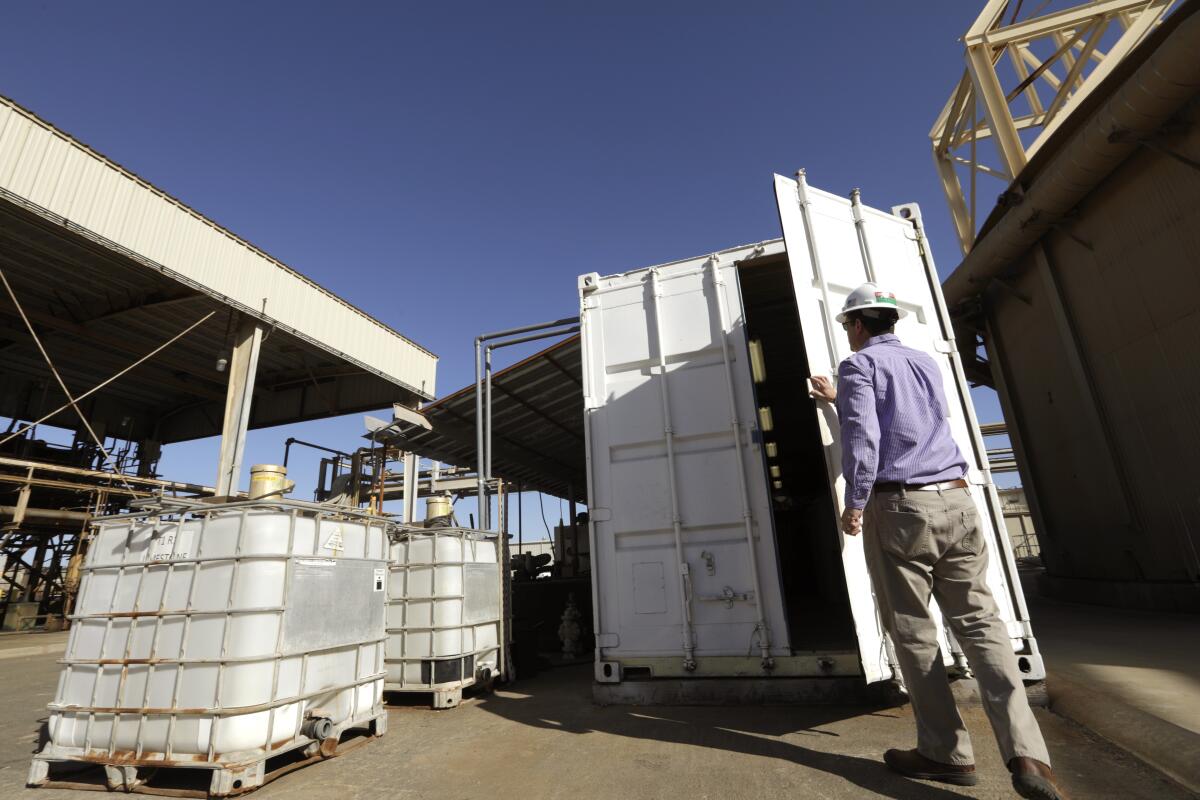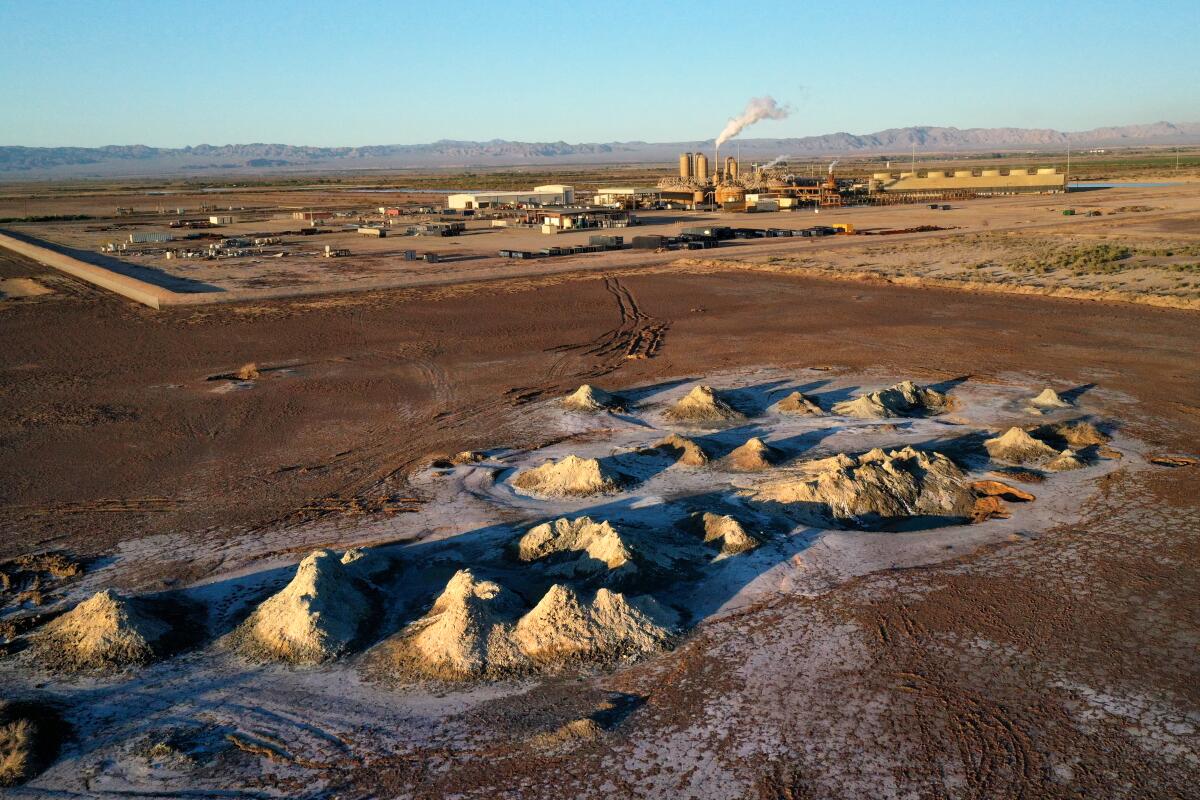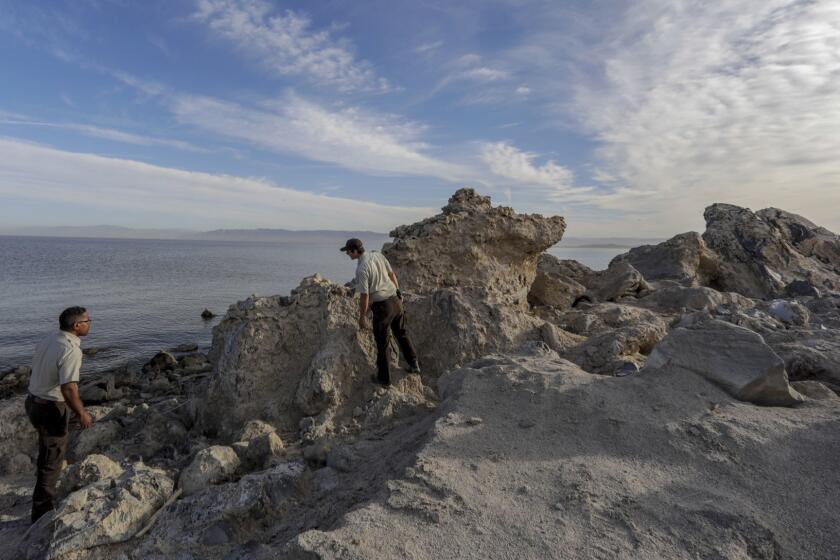Lithium will fuel the clean energy boom. This company may have a breakthrough

EnergySource says it has developed a game-changing method for extracting lithium.
- Share via
Gaze across the Salton Sea, a sparkling oasis in the California desert, and you’ll see white plumes of steam rising against the hazy Chocolate Mountains.
The steam comes from 11 geothermal power plants, nestled between the accidental lake and the verdant farm fields of the Imperial Valley. The area has been churning out climate-friendly geothermal energy since the 1980s, long before solar panels and wind turbines became cheap and abundant.
The geothermal plants could soon contribute to California’s war against climate change in a new way: by producing lithium, a key ingredient in batteries that power electric cars and store solar power for use after dark.
Companies have tried for decades to extract lithium from the super-heated underground fluid used for energy generation at the southern end of the Salton Sea, home to one of the world’s most powerful natural geothermal hot spots. Just a few years ago, a technology start-up called Simbol Materials went bust shortly after Elon Musk’s Tesla Inc. offered to buy it for $325 million.
Now another company says it has solved the lithium problem.
The process begins in a 45-foot-long shipping container at the John L. Featherstone geothermal plant, a few miles from the lake’s receding shoreline. The plant is owned by Chevron Corp., the New Zealand electricity generator Mercury NZ Ltd. and a San Diego-based company called EnergySource.
EnergySource, which built and operates the plant, has filed two patent applications for lithium extraction techniques, after several years working on the process. The firm wouldn’t allow photographs to be taken inside the shipping container during a recent tour, for fear of revealing details to competitors.
But Chief Operating Officer Derek Benson offered a peek inside the box, which was crowded with tanks and other equipment and emitted a steady hum.
“We’ve got it all instrumented up — just a small version of the commercial unit,” Benson said.

Benson said EnergySource has produced “kilograms” of battery-grade lithium. A commercial extraction facility, he estimated, could produce 16,000 tons of lithium carbonate equivalent annually, with the potential for around 100,000 tons if the other Salton Sea geothermal plants adopt the firm’s technology.
Demand for the metal is steadily rising, to supply production of the rechargeable lithium-ion batteries used in electric cars, energy storage systems and smartphones. Analysts at Bloomberg New Energy Finance project global lithium demand will grow from 300,000 tons in 2017 to 1.8 million tons in 2030.
EnergySource’s plant wouldn’t rank among the world’s biggest lithium production facilities, said Logan Goldie-Scot, head of energy storage research at Bloomberg New Energy Finance. But it would be the first major U.S. source, and it could represent an early step toward a domestic battery supply chain.
Today, most of the world’s lithium comes from mines in Australia and South America, while China dominates battery manufacturing.
A small Cessna soared high above the Mojave Desert recently, its engine growling in the choppy morning air.
Efforts to extract lithium at the Salton Sea could unite environmentalists — who decry the destructive evaporation ponds used to produce the metal in South America — and national security hawks, who are loath to rely on other countries for a mineral poised to play a key role in powering the U.S. economy. The Trump administration included lithium on a list of 35 minerals “critical to the economic and national security of the United States” last year.
If the Imperial Valley can eventually produce 50,000 to 100,000 tons of lithium, “that would clearly be impactful from a global level,” Goldie-Scot said.
EnergySource isn’t ready to produce thousands of tons of lithium just yet: The company says it needs to raise $350 million to build a commercial-scale extraction facility. In order to secure that financing, EnergySource probably has to sign up a buyer for most or all of the lithium it plans to produce.

It also isn’t the only energy company with big plans for the Salton Sea.
An Australian firm called Controlled Thermal Resources is trying to build a geothermal power plant and a lithium extraction facility capable of producing 15,000 tons by 2023 and 75,000 tons by 2027. The company has leased thousands of acres from the Imperial Irrigation District on top of one of the most potent spots in the underground geothermal field, and it’s negotiating financing to drill exploratory wells next year, Chief Executive Rod Colwell said.
There’s more than enough lithium buried in the geothermal reservoir for multiple companies to succeed, Colwell said.
“Luckily we’re sitting on the largest known U.S. reserve of lithium,” he said. “It’s a wonderful resource, and we’re all working very hard to realize it.”
Still, potential investors will know the history of mineral extraction at the Salton Sea is checkered with failures.
Simbol Materials is only the latest example.
Warren Buffett’s Berkshire Hathaway Energy, which owns 10 of the 11 geothermal plants in the area, abandoned an expensive initiative to produce zinc in the early 2000s. More recently, Berkshire tried unsuccessfully to find a partner for lithium production.
As long ago as 1979, before any geothermal plants had been built in the area, the federal government gave a San Diego company a $450,000 contract to “assemble a geothermal brine mineral recovery unit” along the southern shore of the Salton Sea, the Imperial Valley Press reported at the time.
“This technique could provide a means of recovering valuable minerals such as iron, manganese, lead, zinc and lithium,” the newspaper reported.

The difficulties stem from the unique qualities of the Salton Sea geothermal resource, particularly its high temperature and salt content.
Energy companies drill wells to access the underground fluid, which is thousands of feet below ground and naturally heated to 500 degrees Fahrenheit or more. The super-heated liquid — known as “brine” because it contains so much salt — has no relationship with the waters of the Salton Sea, which were deposited on the desert floor more than 100 years ago when an irrigation canal carrying Colorado River water to the Imperial Valley burst open.
Assemblyman Eduardo Garcia watched with ill-disguised frustration as a hearing aimed at expediting state projects to restore habitat and control dust storms at the shrinking Salton Sea instead dissolved into discussion of why the efforts were falling further behind schedule.
To produce electricity, geothermal plant operators pump the super-heated underground fluid through pipes, gradually lowering the pressure on the fluid to create steam. Just as at a traditional power plant, the steam turns turbines that generate electricity.
At the end of the process, geothermal plants re-inject the cooled water and condensed steam back into the underground rock formation, replenishing the reservoir and keeping the process renewable.
The goal has always been to extract minerals at some point during that process, before the brine is injected back into the underground reservoir.
Berkshire Hathaway Energy is working with the federal Department of Energy to address the engineering challenges that have stymied lithium extraction at the Salton Sea, according to Jonathan Weisgall, the company’s vice president for government relations. He isn’t expecting quick or easy solutions.
The lesson from Simbol Materials, he said, is that “you can’t go from one one-thousandth commercial scale to full commercial scale.”
“Potential investors saw too much risk without going from pilot to demonstration,” he said.
EnergySource originally gave Simbol a chance to extract lithium from its brine. But after Simbol collapsed, the firm set out to develop its own process.
Eric Spomer, EnergySource’s president and chief executive, said his company has succeeded where others have failed by stringing together commercially proven technologies that have been used in mining and other industries.
He described three primary steps. The first takes place in the shipping container, where heavy metals are removed from the brine after it has been used to generate electricity. The second step happens elsewhere at the power plant, and involves a selective adsorbent — Spomer described it as a “sponge” — that soaks up lithium while leaving other minerals dissolved in the brine.

The adsorbent is paired with a mechanical apparatus that “dramatically improves the efficiency of the sponge,” Spomer said. He called the combination a “game changer” that could be applied to mineral-rich brines around the world, improving lithium yields and dramatically reducing processing times.
“We can concentrate and purify lithium within minutes/hours. And their process takes 18 months,” Spomer said, referring to South American operations.
In the third step, EnergySource sends its lithium to an Illinois facility owned by Veolia, a French resource management conglomerate, which converts the material to a battery-grade product. Once a commercial extraction facility is built at the Featherstone plant, Spomer said, the third step will happen on site.
EnergySource says its facility will be fully operational by 2023.
In addition to producing lithium, the company’s efforts could jump-start the local geothermal industry, which has been mostly dormant this century.
Eight of the 10 geothermal plants owned by Buffett’s Berkshire Hathaway Energy were built in the 1980s and 1990s, with the other two coming online in 2000. Since then, geothermal’s high price point has mostly ground development to a halt, even as California has demanded higher and higher levels of clean energy. The one exception is EnergySource’s Featherstone plant, which opened in 2012, at a time when solar power was still relatively expensive.
Geothermal advocates say the technology has a key role to play in California’s future because it can generate climate-friendly electricity around the clock — unlike solar and wind farms, which are unlikely to meet all of society’s energy demands on their own, even when paired with giant batteries.
Lithium extraction could make it easier for developers to finance new geothermal plants, by offering an additional revenue stream to attract investors.

Geothermal and lithium development could also benefit Imperial County, which has California’s highest unemployment rate and one of its lowest median household incomes. EnergySource estimates its commercial lithium plant would generate $25 million a year in “direct economic benefits” including employee salaries, utility payments, royalties and taxes, with an annual maintenance program infusing an additional $60 million into the local economy.
Imperial County officials have heard those sorts of promises before. They’ve never panned out.
But Ryan Kelley, who chairs the county’s Board of Supervisors, said he’s “cautiously optimistic” EnergySource will actually get a lithium facility built.
“Just one plant would be significant,” he said. “If we could see a half dozen of them, it would change the economic forecast for the county.”








